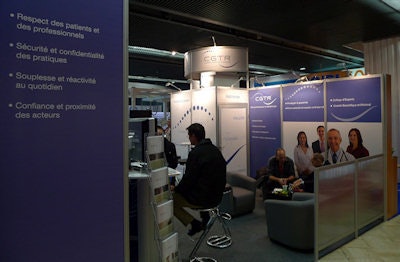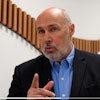
Click here for the French translation of this article.
PARIS - While everyone else is trying to fast-forward teleradiology networks and increase speed in connecting medical imaging with expert readers, some hospital doctors at the sharp end are looking to hit the pause button. They even liken teleconsultations to a runaway train and want to regain control of the process.
"We are absolutely overwhelmed at the Curie Institute by these requests for our opinion. It is exasperating," noted Dr. Sylvia Neuenschwander, head of imaging at the prestigious institute and French Radiology Society (SFR) president. "Please, let's have no more tele-expertise before we can think things through. We need to know the objectives, there needs to be well-founded goals, and we need not only the technical structures but also the functional organization. And then we need dedicated resources, especially the time and the people."
In a session devoted to "Télé-expertise en radiologie," held at the annual congress of SFR, les Journées Françaises de Radiologie (JFR), it was evident that more efficient systems and procedures are necessary to cope with rising demands.
 Teleradiology providers promoted their services in the exhibition hall during JFR. Photo courtesy of Dr. Robert Lavayssière.
Teleradiology providers promoted their services in the exhibition hall during JFR. Photo courtesy of Dr. Robert Lavayssière.Time spent on teleconsultations long ago passed two hours per day and is approaching four hours, according to Dr. Hubert Ducou le Pointe, head of radiology at the University Hospital Armand Trousseau in Paris and an active member of G4, a nonprofit association gathering all the actors in French radiology, including SFR, the teaching universities, the national federation of independent radiologists, and the hospital radiology groups.
"The number of tools has exploded, along with the number of consultations demanded," he said. "People are getting lost in all the tools being installed and the confusion that comes with different systems for local, regional, national, and international requests for consultation. And there is always this constant pressure for speed," he said.
In the current calm before the next-generation high-speed networks are connected, Neuenschwander said the number of requests flooding her email inbox is already more than can be reasonably managed. There are still colleagues good enough to select images of concern, she said. "If they want me to look at 20 images, then I will find 20 emails in my box, each with an image attached."
 Radiologists at the Curie Institute are overwhelmed with requests for a second opinion, said SFR President Dr. Sylvia Neuenschwander.
Radiologists at the Curie Institute are overwhelmed with requests for a second opinion, said SFR President Dr. Sylvia Neuenschwander.
Ducou le Pointe agreed that the nonselection of images with indiscriminant downloading to a consulting radiologist is a recent source of frustration. Requests arrive with a deceptively simple link to a patient file, he said, and when opening it, radiologists find three sets of CT scans each with 3,000 slices.
Teleradiology networks are also introducing greater transparency into teleconsultations, breaking down a culture of collegial collaboration. SFR guidelines fail to address the rights of patients in teleconsultations, according to Dr. Liliane Ollivier, a radiologist at the Curie Institute. Yet French law clearly describes the rights of a patient to be informed of the results, told who the expert consultant is, and given a guarantee about the quality of the consultation. The records of the consultation and all responses must be stored in the patient's record, of which the patient is the custodian in France.
Opening new networks will increasingly bring a greater number of actors into the content of teleconsultations, she cautioned. And with consequences that cannot yet be appreciated for the patient, the radiologist, and the healthcare system, as she demonstrated in three cases of teleradiology that went wrong.



















